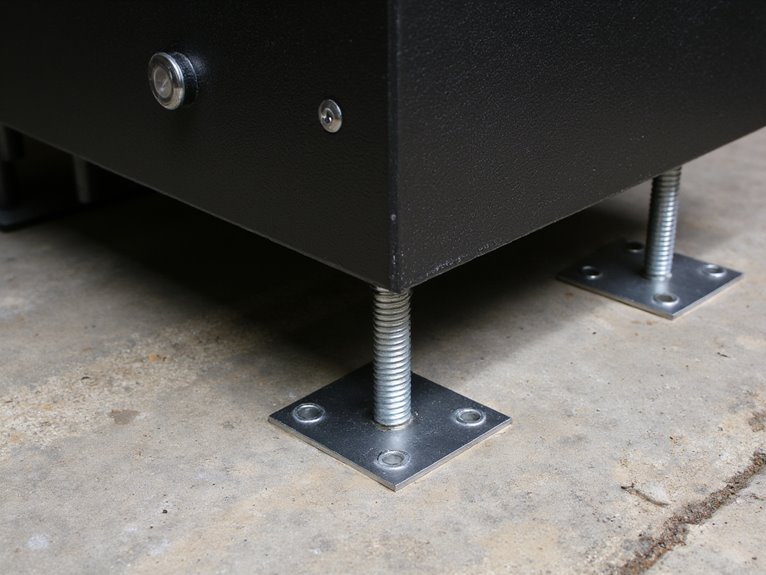Anchoring a Gun Safe: Weight Distribution and Mounting Techniques
You’ll secure your gun safe by distributing weight centrally with heavier firearms, then anchoring it using 3/8″ lag screws for wood subfloors or 1/2″ wedge anchors for concrete. Quality safes weighing 600-2,000 pounds require Grade 8 bolts that accommodate base thickness and floor coverings. Position lighter accessories toward edges to prevent tipping, and consider steel plate reinforcement beneath concrete slabs for enhanced tamper resistance. Proper installation techniques and maintenance protocols guarantee maximum security performance.
We are supported by our audience. When you purchase through links on our site, we may earn an affiliate commission, at no extra cost for you. Learn more. Last update on 18th December 2025 / Images from Amazon Product Advertising API.
Notable Insights
- Distribute weight by placing heavier firearms centrally and lighter accessories toward edges to prevent tipping hazards.
- Use 3/8″ lag screws for wood subfloors and 3/8″ to 1/2″ wedge anchors for concrete foundations.
- Install Grade 8 corrosion-resistant bolts with full embedment depth to resist pull-out and lateral forces effectively.
- Mount safes to concrete slabs with additional steel plates beneath for enhanced tamper resistance and security.
- Locate manufacturer-designed anchor points before drilling and ensure bolt length accommodates base thickness and floor coverings.
Weight Distribution Principles for Maximum Stability
When selecting a gun safe, weight serves as your first line of defense against theft, with most quality units ranging from 600 to over 2,000 pounds when fully loaded. This mass creates natural resistance to forced removal attempts.
Heavy gun safes weighing 600-2,000 pounds provide superior theft protection through sheer mass that deters forced removal attempts.
Proper weight distribution inside your gun safe directly impacts both security and structural integrity. You’ll want to place heavier firearms and ammunition centrally, positioning lighter accessories toward the edges. This balanced approach prevents tipping hazards and reduces stress on locking mechanisms.
Internal weight distribution affects your safe’s stability during movement and daily use. Uneven loading creates pressure points that can compromise floor integrity and cause mechanical component failure over time. Proper anchoring enhances the security benefits of your safe’s substantial weight by creating additional resistance to theft attempts.
Even weight spread extends your safe’s lifespan while maintaining peak security performance through consistent structural balance. Many manufacturers recommend floor bolting for warranty compliance, as failure to secure the safe properly may void warranty protection claims.
Floor Anchoring Methods and Hardware Requirements
Your gun safe’s pre-drilled anchor holes determine the exact placement and spacing requirements for your floor mounting hardware.
You’ll need to select bolts that match both your flooring material and the diameter specifications of these factory holes—typically requiring 3/8″ lag screws for wood subfloors or 3/8″ to 1/2″ wedge anchors for concrete.
The bolt length must provide adequate penetration depth while accounting for your safe’s base thickness and any floor coverings.
Pre-Drilled Hole Placement
Most gun safes come equipped with pre-drilled anchor holes that serve as your starting point for secure floor mounting. Before beginning installation, locate and remove plastic caps covering these holes on your safe’s floor or back panel.
Inspect the bottom carefully for manufacturer-designed anchor points—never drill if no indentations exist.
Position your safe in its final location and mark drill points on the floor using a pencil through the base holes. This guarantees perfect alignment during installation.
Pre drilled holes eliminate guesswork but present installation challenges on carpeted surfaces. You’ll need to carefully cut away carpet sections to expose the concrete underneath without damaging surrounding areas.
If your safe lacks pre-drilled holes, consult manufacturer instructions for proper placement locations and recommended drilling specifications. For wall-mounted installations, these pre-drilled mounting holes typically reduce installation time to under 30 minutes when proper hardware is used.
Bolt Selection Requirements
The success of your gun safe installation depends entirely on selecting the right anchor bolts for your specific floor type and security requirements.
You’ll need high-strength hardware that can withstand both pull-out forces and lateral stress during break-in attempts.
Essential bolt specifications include:
- Bolt grade: Use Grade 8 bolts or equivalent for maximum load-bearing capacity in concrete applications
- Proper length: Choose bolts allowing full anchor embedment plus adequate length to secure the safe base through any floor coverings
- Corrosion resistance: Select zinc-plated or stainless steel bolts for durability in garage or basement environments
Hex head bolts facilitate proper torque application with standard tools.
Avoid threading drop-in anchors too deeply, as this displaces the expansion mechanism and reduces holding strength considerably.
Steel Slab Mounting for Enhanced Security
When you’re mounting a gun safe to a concrete slab, you’ll achieve the most secure installation possible for residential applications. Steel deterrents greatly enhance your safe’s protection beyond standard anchoring methods.
You can install additional steel plates underneath your safe to increase weight and tamper resistance. Layering techniques involve applying steel sheets to safe walls using strong epoxy or mechanical fasteners, creating multiple barriers against cutting tools.
“L” shaped steel sheets mounted on tops and sides provide extensive forced-entry protection. These augmentation layers must be securely attached to prevent easy removal.
The concrete slab supports this additional steel weight as static load without structural concerns. Multiple steel layers integrated into your installation create a fortress-like defense system that deters even determined burglary attempts through increased drilling and cutting resistance.
Safe Handling and Moving Equipment Considerations
Moving a gun safe requires specialized equipment and careful planning to prevent injury and property damage. Essential safety gear includes steel-toe boots, leather gloves, and back braces for protection during transport.
Proper safety equipment and meticulous planning are absolutely critical when relocating heavy gun safes to avoid serious injuries and costly property damage.
Heavy-duty appliance dollies rated for your safe’s weight are mandatory—most gun safes weigh 200-800 pounds.
Safe transport techniques demand proper preparation and equipment:
- Use load-rated dollies and securing straps to maintain control during movement.
- Empty the safe completely to reduce weight and protect contents from damage.
- Plan your route carefully by measuring doorways, stairs, and floor load capacity.
Professional movers handle safes exceeding 600 pounds safely. They possess specialized equipment and experience for complex moves.
DIY moving works for lighter safes when you follow proper lifting techniques and use appropriate equipment.
Load Balancing Techniques and Torque Specifications
Proper load balancing forms the foundation of secure gun safe installation, directly affecting both stability and anchoring effectiveness.
You’ll need to center the safe’s weight evenly across all mounting points to prevent stress concentration on individual fasteners. Use leveling tools to verify uniform contact with the substrate before tightening any bolts.
Torque calibration requires precision measuring tools to achieve manufacturer specifications. For standard ½” mounting bolts, apply approximately 30 ft-lb of torque using a calibrated torque wrench.
Over-tightening damages substrates, while under-tightening allows loosening over time. Install lock washers or thread lockers to maintain security.
Load monitoring continues after installation. Check torque specifications periodically as settling occurs.
Redistribute weight if you notice uneven gaps beneath the safe’s base, ensuring consistent anchoring performance throughout the safe’s service life.
Additional Security Enhancements and Maintenance
Beyond proper anchoring, you’ll want to implement enhanced security hardware that creates multiple layers of protection for your gun safe.
Regular maintenance inspections guarantee your locking mechanisms, environmental controls, and mounting systems continue operating at peak performance levels.
These additional measures transform a basic anchored safe into an all-encompassing security system that protects against both theft attempts and environmental damage.
Most quality gun safes come with pre-drilled holes for secure wall or floor mounting, complete with expansion bolts to ensure proper installation.
Consider adding security cables and alarm systems that provide anti-theft alerts when unauthorized access attempts are detected.
Enhanced Security Hardware
While basic anchoring provides foundational security for your gun safe, advanced security hardware creates multiple layers of protection that considerably increase resistance to sophisticated break-in attempts.
Modern gun safes integrate multiple lock technologies to maximize security effectiveness:
- Redundant Lock Systems – Combining electronic keypads with mechanical dial locks provides backup access while eliminating single-point vulnerabilities to picking or hacking attempts.
- Relocker Mechanisms – Glass relockers trigger secondary bolt systems when broken by drilling, while heat relockers activate if cutting torches reach critical temperatures.
- Internal Protection Systems – Lock pressure relievers and clutch drive mechanisms prevent damage during forced entry attempts, maintaining lock integrity.
Electronic locks offer quick access but require battery maintenance.
Biometric reliability depends on clean sensors and proper finger placement.
Mechanical advantages include independence from power sources and resistance to electronic vulnerabilities.
Regular Maintenance Inspections
Even the most sophisticated security hardware won’t protect your firearms if mechanical components fail from neglect or environmental damage. Your inspection frequency should occur every six months to identify wear, corrosion, or damage on exterior and interior surfaces.
Focus on lock mechanisms, hinges, and seal integrity during each assessment. Create a maintenance checklist covering all critical components. Inspect bolts and locking mechanisms, applying grease to reduce friction.
Check fire seals for cracks that compromise fire-resistance capability. Clean interior surfaces biannually using soft cloths and mild solutions—avoid abrasive chemicals that damage finishes.
Monitor humidity levels with desiccants or electric dehumidifiers. Electric dehumidifier rods effectively control moisture in safes up to 200 cubic feet and provide continuous protection against firearm corrosion. Maintain your target relative humidity between 30-50% to prevent moisture-related damage and excessive dryness that could affect different firearm materials. Document all inspections, cleaning, and repairs to track your safe’s condition over time.
This proactive approach prevents security compromises and guarantees reliable long-term performance.
Frequently Asked Questions
Can I Anchor a Gun Safe on the Second Floor of My Home?
Yes, you can anchor a gun safe on your second floor with proper second floor safety precautions. Weight considerations require evaluating floor joists and using appropriate anchors for secure mounting.
What Permits or Codes Apply When Anchoring Safes in Residential Areas?
You’ll need to check permit requirements with your local building department, as local codes vary by jurisdiction. Some areas require permits for structural modifications, while others have restrictions for post-tension concrete or fire safety compliance.
On a final note
You’ve now got the essential knowledge to anchor your gun safe properly. Weight distribution across multiple anchor points prevents tipping and enhances theft resistance. Choose appropriate hardware for your floor type—concrete anchors for slabs, lag bolts for wood subfloors. Don’t skip the torque specifications; they’re critical for maintaining anchor integrity. Regular maintenance checks guarantee your installation stays secure. Remember, a properly anchored safe won’t budge when someone’s trying to remove it.

